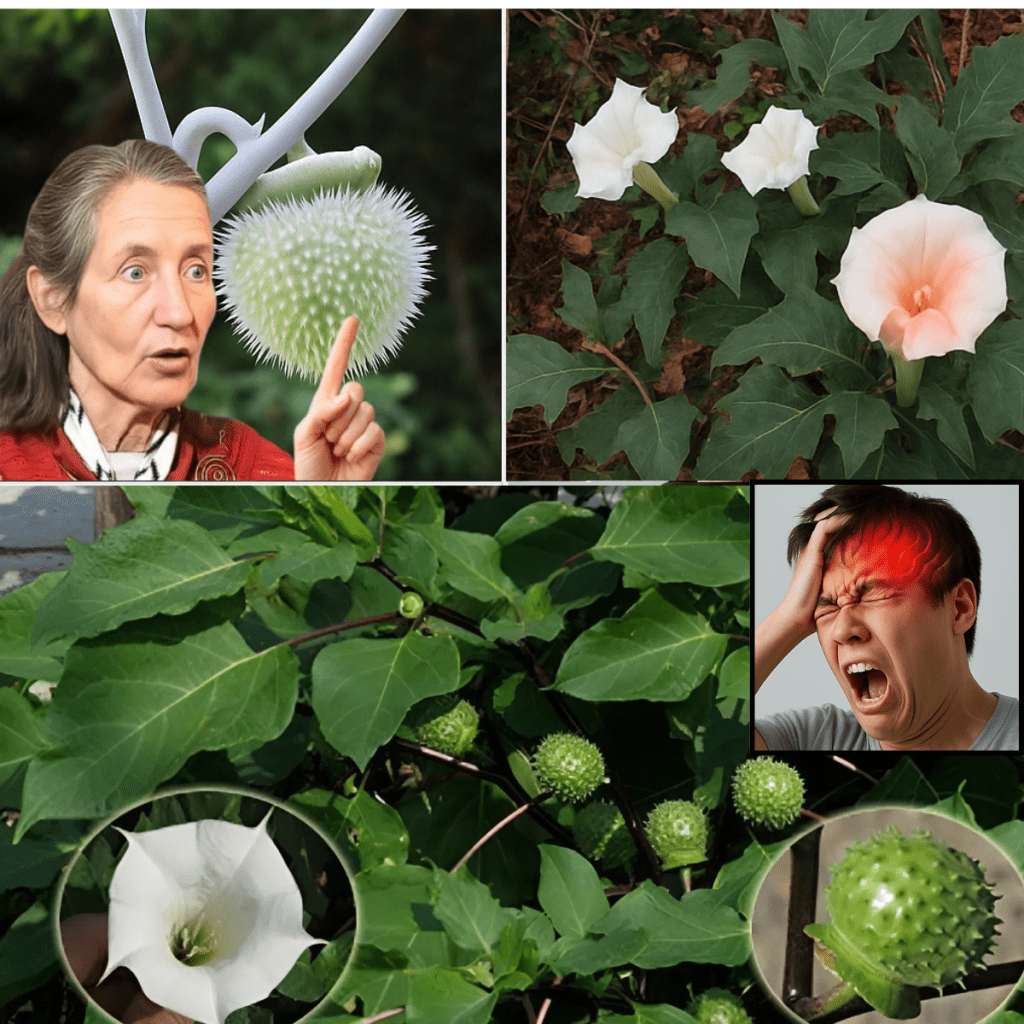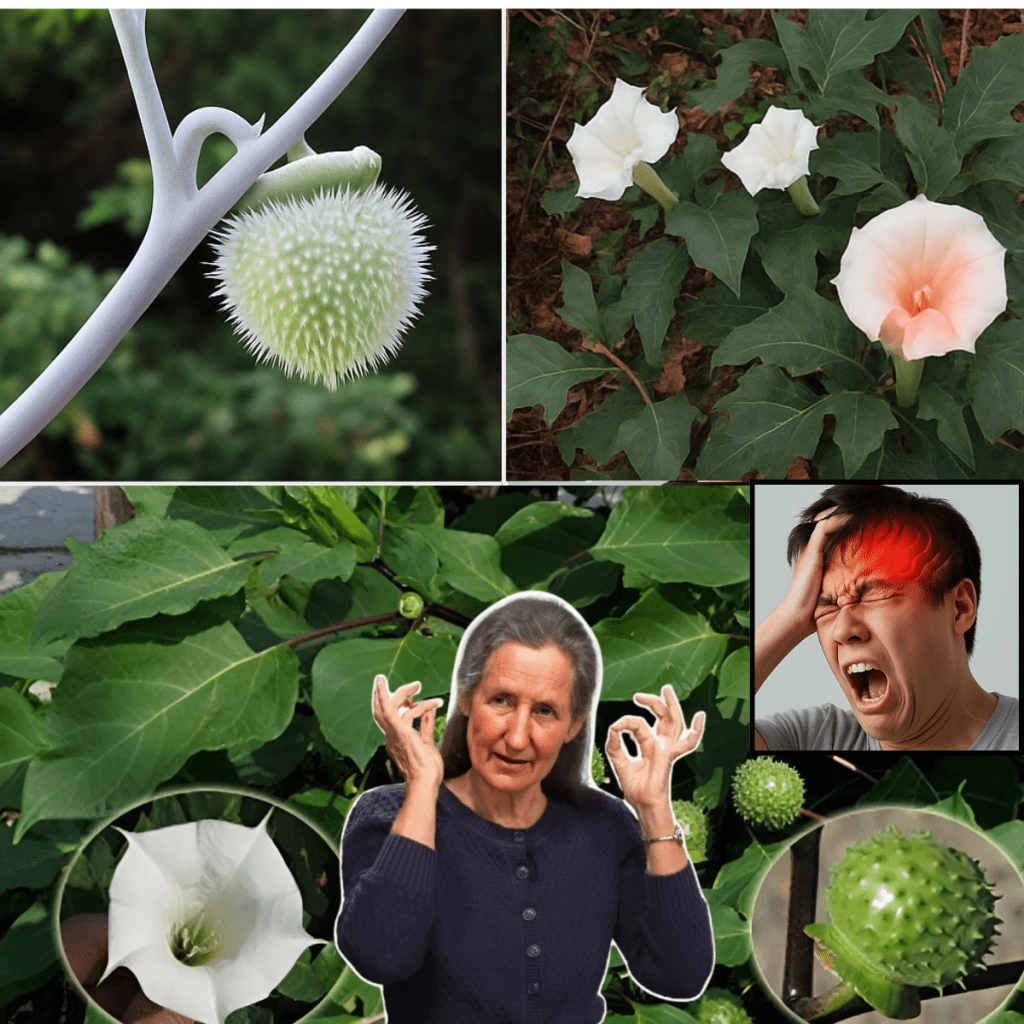Imagine stumbling upon a plant so breathtakingly beautiful that it seems to whisper promises of nature’s magic. Its trumpet-shaped flowers, glowing white or purple under the sun, beckon you closer, tempting you to touch or even taste its vibrant leaves. But what if this enchanting plant hides a sinister secret—one that could send you spiraling into a nightmare of hallucinations, heart palpitations, or worse? Meet Datura stramonium, a stunning yet lethal wildflower that thrives in plain sight, waiting to ensnare the unsuspecting. This isn’t just a plant; it’s a silent predator, and its dangers could be closer to you than you think.
For gardeners, foragers, or anyone who cherishes time outdoors, Datura stramonium is a hidden threat that blends seamlessly into landscapes across the United States. Found along roadsides, in neglected garden corners, or even sprouting uninvited in your backyard, this plant’s charm is a deadly facade. Every part—leaves, flowers, seeds, and roots—carries potent toxins that can wreak havoc on your body, especially if you’re an older adult or have underlying health conditions. This article will unravel the captivating yet terrifying truth about Datura stramonium, arming you with the knowledge to stay safe while keeping you hooked on its chilling story.

🌸 Why Datura Stramonium’s Beauty Is a Dangerous Trap
At first glance, Datura stramonium looks like a gift from nature. Its large, elegant flowers unfurl like trumpets, catching the eye with their soft hues of white or violet. The plant’s spiky, walnut-sized seed pods add an intriguing texture, making it seem like a perfect candidate for an ornamental garden. For seniors who find joy in tending their flower beds or exploring natural remedies, it’s easy to mistake this plant for something harmless or even beneficial. After all, who would suspect that such a lovely specimen belongs to the notorious nightshade family, alongside both edible crops like tomatoes and deadly cousins like belladonna?
The reality is far darker. Datura stramonium is one of the most toxic plants in North America, and its deceptive beauty masks a chemical arsenal that can turn a casual encounter into a medical emergency. Whether you’re pulling weeds, foraging for herbs, or simply brushing past it on a walk, this plant poses a serious risk. Its toxins can be absorbed through the skin, inhaled, or ingested, making it a threat to everyone—especially older adults, whose bodies may struggle to process such potent compounds. The question isn’t just why this plant is so dangerous, but how something so alluring can hide such a lethal secret.
☠️ The Toxic Powerhouse: What Makes Datura Stramonium Deadly
The true danger of Datura stramonium lies in its chemical makeup. This plant is packed with tropane alkaloids—powerful compounds like atropine, scopolamine, and hyoscyamine that disrupt the body’s nervous system. These chemicals block acetylcholine, a critical neurotransmitter that helps your brain communicate with your muscles and organs. The result? A cascade of symptoms that can range from uncomfortable to catastrophic.
For seniors, the stakes are even higher. Many older adults take medications for heart conditions, blood pressure, or other chronic issues, and Datura’s toxins can interact dangerously with these drugs. Even a small exposure—say, chewing a leaf or swallowing a few seeds—can trigger severe reactions. The plant’s toxicity isn’t consistent either; it varies depending on the season, soil, or even the plant’s age, making it impossible to predict how much is “too much.” One moment, you’re admiring a flower; the next, you’re grappling with symptoms that could land you in the hospital.
🚨 The Alarming Symptoms of Datura Stramonium Poisoning
The effects of Datura stramonium poisoning are as swift as they are terrifying. Symptoms can appear within 30 to 60 minutes of exposure and may linger for up to 48 hours, turning a moment of curiosity into days of distress. Here’s what you need to watch for:
🌡️ Dry mouth and extreme thirst: The plant’s toxins shut down saliva and sweat production, leaving you parched and uncomfortable.
👁️ Dilated pupils and blurred vision: Your eyes may become sensitive to light, making it hard to see clearly or focus.
❤️ Rapid heartbeat: This can strain the heart, posing a particular risk for seniors with cardiovascular issues.
🧠 Hallucinations and delirium: Vivid, often frightening visions can lead to confusion, agitation, or even aggression.
⚡ Seizures or coma: In the worst cases, poisoning can escalate to life-threatening neurological crises.
For older adults, these symptoms can be mistaken for other conditions, like dehydration, heatstroke, or medication side effects. This confusion can delay critical treatment, making it vital to recognize the signs and act quickly. If you or someone you know experiences these symptoms after handling an unfamiliar plant, don’t wait—seek help immediately.
🌱 Where Datura Stramonium Hides: Everyday Encounters
One of the most unsettling aspects of Datura stramonium is how common it is. This plant doesn’t lurk in remote jungles; it thrives in places you visit every day. From suburban gardens to rural pastures, it pops up uninvited, blending in with other greenery. Here are the most common ways seniors and their loved ones might encounter it:
🧤 Gardening mishaps: Datura stramonium can sprout among your roses or vegetables, mistaken for a weed or an ornamental plant.
🌿 Foraging mistakes: Those seeking natural remedies might confuse it with safe herbs, especially without expert knowledge.
🤲 Accidental contact: Brushing against the plant or handling its seeds can allow toxins to seep through cuts or mucous membranes.
🐶 Pet or grandchild exposure: Curious pets or young children may chew on the plant, putting the entire household at risk.
The plant’s accessibility makes it a silent threat. A single misstep—pulling it without gloves, mistaking its seeds for something edible, or letting a pet roam near it—can lead to disaster. Seniors, with slower metabolisms and potential health vulnerabilities, are especially at risk, but the danger extends to anyone who crosses its path.
🛡️ How to Protect Yourself from Datura Stramonium
Staying safe from Datura stramonium doesn’t mean abandoning your love for gardening or nature. With a few simple precautions, you can enjoy the outdoors while keeping this deadly plant at bay. Here are five practical steps to protect yourself and your loved ones:
🔍 Learn to identify the plant: Familiarize yourself with its trumpet-shaped flowers, spiky seed pods, and jagged leaves. Use a plant identification app or consult a local gardening expert if you’re unsure.
🧤 Wear protective gear: Always use gloves and long sleeves when gardening or clearing weeds to avoid skin contact with unknown plants.
👶 Supervise pets and children: Keep them away from wild plants, especially in areas where Datura stramonium is known to grow.
🌿 Avoid wild foraging: Unless you’re a trained botanist, stick to store-bought herbs and avoid experimenting with wild plants.
🗑️ Remove it safely: If you spot Datura stramonium in your yard, dig it out with tools, bag it securely, and dispose of it properly—never burn it, as the smoke can carry toxins.
These steps are simple but powerful. By staying vigilant, you can continue to nurture your garden or explore nature without fear of this hidden danger.
🚑 What to Do if Poisoning Strikes
If you suspect Datura stramonium poisoning, every second counts. The toxins act quickly, and delaying treatment can lead to severe complications, especially for seniors. Here’s what to do:
📞 Call for help immediately: Dial 911 or Poison Control at 1-800-222-1222 and provide details about the plant and symptoms.
🚫 Don’t induce vomiting: This can worsen the situation, particularly for those with heart or respiratory issues.
🏥 Seek medical care: Treatments like activated charcoal or specific antidotes can neutralize the toxins, but only a medical professional can administer them.
🌱 Bring a sample if possible: If you can safely collect a piece of the plant using gloves, it can help doctors confirm the diagnosis.
Quick action can be a lifesaver. Thousands of people are treated for Datura poisoning each year, and early intervention often prevents the worst outcomes. Don’t let embarrassment or uncertainty stop you—act fast to protect yourself or your loved ones.

🌟 Why Awareness Is Your Best Defense
Datura stramonium is a master of deception, hiding its lethal nature behind a veil of beauty. But knowledge is power. By understanding its dangers, recognizing its signs, and taking simple precautions, you can enjoy the outdoors without fear. Share this information with friends, family, or fellow gardeners to keep your community safe. Have a favorite gardening tip or a story about a mysterious plant? Drop it in the comments below—let’s keep the conversation growing!
This plant may be a silent threat, but it doesn’t have to win. Arm yourself with awareness, stay cautious, and let nature’s beauty inspire you—safely.









